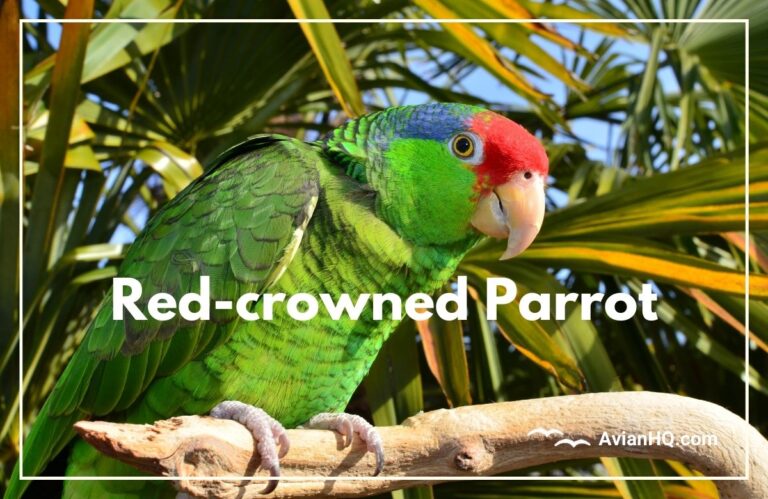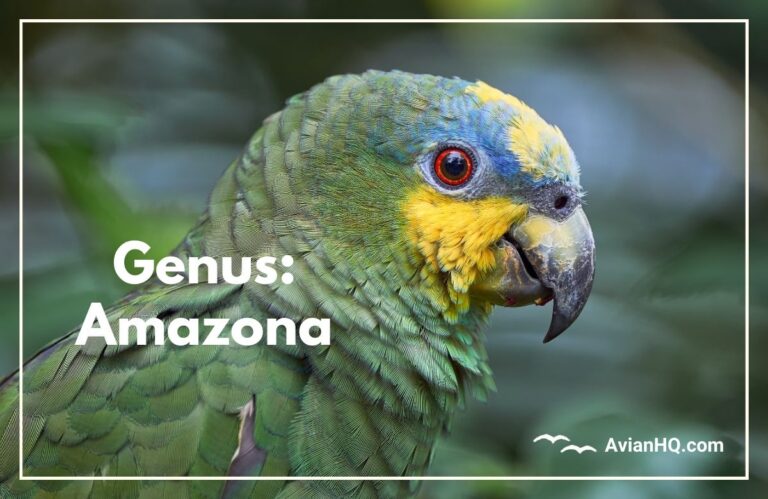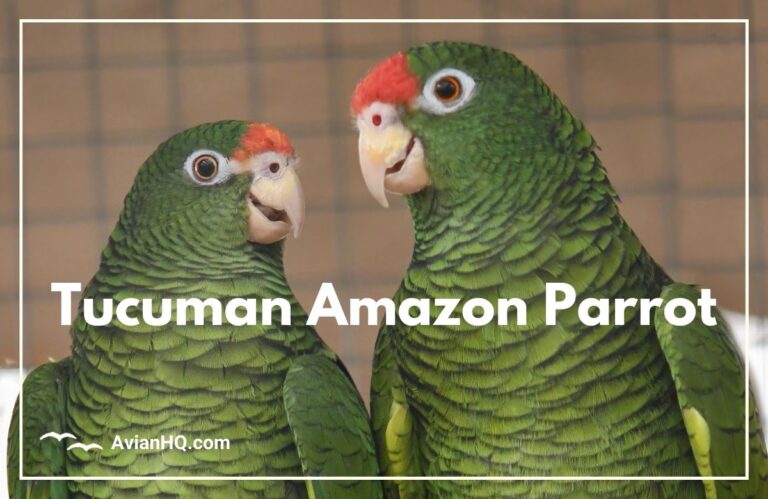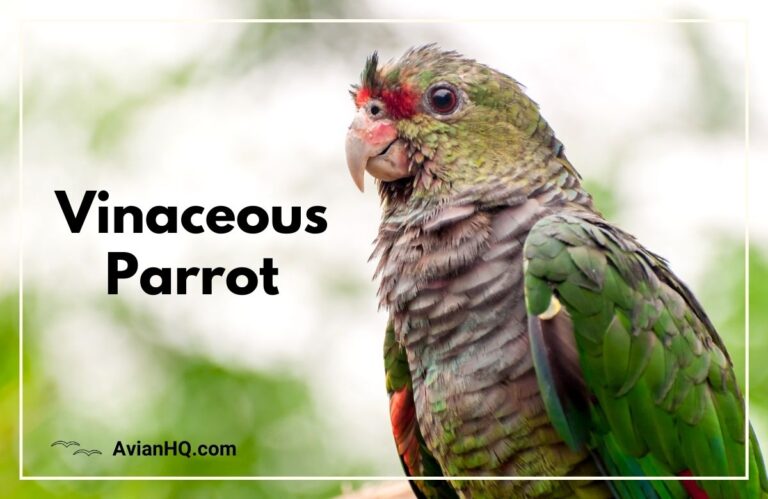White-fronted Parrot (Amazona albifrons)
The White-fronted Parrot, also known as the White-fronted Amazon, is a small, vibrant parrot native to Mexico and Central America. With its bright plumage and comical antics, this little bird hassecured a place in the hearts of many avian enthusiasts.
You’ll quickly be drawn to the White-fronted Parrot’s distinguishing facial markings – bright red feathers around the eyes that resemble spectacles, a white or yellowish forehead, and bluish feathers on the crown. Their bodies display stunning green plumage accented with red and blue on the wings. Standing at just under 10 inches (25 cm) tall, they live up to their title as the smallest members of the Amazon parrot genus.
What the White-fronted Parrot lacks in size, it makes up for in oversized personality! This little bird is fearless, outrageously playful, and eager to form strong bonds with caretakers. Its high intelligence and talking ability add to the appeal.
“They may be tiny, but White-fronted Parrots showcase huge personalities packed inside petite frames!”
In the wild, White-fronted Parrots reside in small flocks ranging from Mexico down into Costa Rica. You’ll encounter them in various habitats from tropical rainforests to drier savannas and woodlands. Their diverse diet includes seeds, fruits, nuts, and leafy greens obtained both in the trees and on the forest floor.
While still reasonably common in Central America, trapping for the pet trade does pose localized threats. Their popularity in aviculture and captivity provides assurance that the White-fronted Parrot will continue entertaining bird lovers for generations to come.
Let’s dive in and explore more about this charismatic mini parrot!
History and Taxonomy
The White-fronted Parrot’s scientific journey began over 200 years ago. This species was first classified by the Swedish naturalist Anders Sparrman in 1788 as Psittacus albifrons, recognizing its distinctive white forehead. Let’s break down some key events and terminology in the taxonomy and naming of this bird.
Scientific Name and Meaning
The White-fronted Parrot’s current scientific name is Amazona albifrons.
- Amazona – The genus containing all Amazon parrots
- albi – From Latin meaning “white”
- frons – Latin for “forehead” or “brow”
So its scientific name essentially translates to “white-browed Amazon parrot” – an apt description for this little green parrot with bold white feathers on its forehead!
Three Recognized Subspecies
Scientists divide the White-fronted Parrot into three distinct subspecies based on slight variations in size, color, and geographic distribution:
- Amazona albifrons albifrons – The nominate race and most widespread subspecies, occurring from western Mexico to southwestern Guatemala.
- Amazona albifrons nana – The “Lesser” White-fronted Parrot, named for its smaller size. Ranges from southeastern Mexico down into northwestern Costa Rica.
- Amazona albifrons saltuensis – Also known as the “Sonora White-fronted Parrot”, inhabiting only northwestern Mexico.
While differences between the subspecies are subtle, being able to identify them can prove important for conservation studies and tracking bird trade.
Physical Appearance
The White-fronted Parrot makes an impression with striking flashes of color on a verdant green canvas. Let’s paint a picture of this small parrot’s physical characteristics and features.
A Miniature Parrot
Reaching lengths of only 9-10 inches (23-25 cm), the White-fronted Parrot claims the title of the smallest Amazon parrot species. But its vivid plumage and oversized personality distract from its petite frame!
Both males and females share a predominantly green coat from head to tail, though males exhibit some key differences:
- Females have solid green “shoulders” on the leading edges of their wings. Their weight ranges between 6.5-8 ounces (184-227 grams).
- Males display vivid red feathers on their wing “shoulders” and may reach 8-8.7 ounces (227-246 grams).
Juveniles start out less vibrant than adults. Their iris eye rings are pale gray, not yellow. And the signature white forehead patch appears yellowish or smaller.
Standout Markings
Several splashy markings set the White-fronted Parrot apart from its relations:
- White Forehead – This parrot wouldn’t live up to its name without the neat white patch front and center! The size and shape of the white varies between individuals from medium patches to nearly spanning between the eyes.
- Blue Crown – Slightly greenish-blue feathers top the forehead.
- Red Eye Rings – Striking red feathers circle outward from the eyes like spectacles. The area of red increases with maturity.
- Blue Wing Flashes – Bright blue feathers accent the bend and outer portion of the wings, revealed in flight or when wings are outstretched.
Shared Amazon Features
Like all Amazon parrots, the White-fronted Parrot sports a short blunt tail, rounded head shape, sturdy curved beak with a upper mandible that hooks downward over the shorter lower half. Its eyes glow yellow encircled by a fleshy white eye ring, and its feet stand zygodactyl with two toes facing forward and two back.
Habitat and Distribution
In the wild, the charismatic White-fronted Parrot resides in Mexico and down through Central America. It occupies diverse environments across a broad landscape.
Native Range
The White-fronted Parrot naturally occurs from western Mexico through Guatemala, El Salvador, Honduras, Nicaragua, and into northwestern Costa Rica. Its range spans both Caribbean and Pacific slopes of the region.
These parrots frequent a mosaic of habitat types within their range, including:
- Tropical rainforests – wet broadleaf forests
- Tropical deciduous forests – drier forests that lose their leaves seasonally
- Savannas – open grasslands with scattered trees
- Riparian corridors – areas along rivers and streams
- Semi-urban areas – suburbs, orchards, and park lands
They seem quite adaptable as long as there are sufficient trees and food sources available.
Introduced Populations
Thanks to escaped pets or intentional releases, small introduced populations of White-fronted Parrots have become established well outside their native distribution:
- Puerto Rico: An exotic breeding population resides mainly in the southwest coastal areas of the island.
- Southern Texas: Groups sighted around Brownsville likely originate from released former pets or aviary birds.
- Southern California: Similarly, feral flocks around Los Angeles County probably stem from escaped captive birds.
Elevational Range
In their home terrain of Mexico and Central America, these parrots generally dwell at elevations up to 3,000 feet (914 meters). But they may descend lower in some areas into sheltered valleys or travel higher temporarily while searching for food sources.
Diet and Feeding Habits
The White-fronted Parrot is well adapted to take advantage of a wide variety of food sources throughout its native range. Its diverse natural diet provides key nutrients and fuels its high activity levels.
Overview of Diet in the Wild
White-fronted Parrots are opportunistic, generalist feeders that exploit many different plants depending on habitat, season, and availability. Their main natural diet includes:
- Fruits: Figs, mangos, papaya, and seasonal berries
- Seeds and nuts: nut seeds, palms, seed pods
- Flowers and buds: nectar, pollen, unfolding flowers
- Greenery: leaves, shoots, sprouts
This species obtains food from many sources – plucking fruits out of trees, cracking open seed pods, raiding corn fields, and foraging through leaf litter on the forest floor. such a varied diet provides carbohydrates as well as healthy fats, proteins, and vitamins.
Feeding Behaviors
White-fronted Parrots employ an array of techniques to access their desired foods:
- Perching and reaching to pick items from branches
- Climbing along limbs and creeping vines
- Hanging upside down to reach best fruits
- Employ foot coordination to grasp and manipulate food
- Use strong beaks to open seeds and extract pulp
- May travel widely between prime feeding areas
These agile parrots feed opportunistically depending on what’s readily available. You might observe them on a single fruiting tree one day, then ground foraging the next. This behavioral flexibility helps support stable populations.
Breeding and Reproduction
Behavior and Ecology of White-fronted Parrots
The White-fronted Parrot exhibits some interesting behavioral patterns and ecological roles where it occurs across Mexico and Central America.
Social Structure
White-fronted Parrots live in small to medium sized flocks most of the year, ranging from pairs up to about 20 birds on average. During the breeding season, they split off into mated pairs to nest.
Outside of breeding, these social birds spend their time:
- Roosting together in communal tree cavities or dense vegetation
- Foraging together in their home ranges
- Conducting friendly social interactions like preening and squabbling
Parrots may also gather in larger flocks of 100-500 individuals where food sources are abundant. Strength in numbers provides safety and easier foraging.
Foraging and Feeding
During the day, White-fronted Parrot flocks forage actively for their varied diet of seeds, fruits, flowers, and greens. Their strong beaks allow them to access well-protected foods.
Some feeding behaviors include:
- Investigating new fruiting trees as they come into season
- Returning routinely to productively fruiting trees
- Harvesting corn once human crops reach the milk stage
- Digging through leaf litter searching for fallen seeds
- plucking buds simultaneously from the same tree
Interactions with Other Species
White-fronted Parrots share habitats and resources with other native wildlife. They may associate with:
- Other parrot species in feeding flocks or at shared roost sites
- Songbirds that nest in adjacent holes
- Predators like hawks that threaten unfledged chicks
- Mammals like coatis that feed on similar fruits
Overall these adaptable parrots fill an important niche as mid-sized omnivores that help disperse seeds and pollen.
The breeding behaviors of White-fronted Parrots play an important role in sustaining populations of this small tropical parrot. Let’s explore their nesting ecology, breeding seasonality, and chick rearing patterns.
Nest Sites
White-fronted Parrots nest in tree cavities, either natural hollows or old woodpecker holes. The birds may excavate the cavity further with their beaks to customize the space. Nest height ranges from 16-65 feet (5-20 meters) high depending on tree size and availability.
Favored nest trees include:
- Mangos
- Laurels
- Palms
- Oak trees
Both sexes help defend the nest site. They typically reuse and improve the same nesting cavity in subsequent years.
Breeding Seasonality
Timing of breeding corresponds with the dry spring season from February to July across most of these parrots’ range. This ensures maximum food availability during chick rearing.
Courtship displays begin in February and March, where mated pairs strengthen social bonds. The female typically lays 3-4 white eggs within the nest cavity.
Incubation and Fledging
Only the female White-fronted Parrot incubates the eggs, for approximately 26 days. During this time, the male regularly brings food to feed his mate.
Once the chicks hatch, both parents supply regurgitated food like fruit pulp and seeds. Nestlings fledge at around 9-11 weeks old but continue to receive supplemental feedings as they build flight skills.
The total time from egg laying to independence ranges about 12-16 weeks, allowing young birds to grow and develop properly under parental care.
Behavior and Ecology
The White-fronted Parrot exhibits some interesting behavioral patterns and ecological roles where it occurs across Mexico and Central America.
Social Structure
White-fronted Parrots live in small to medium sized flocks most of the year, ranging from pairs up to about 20 birds on average. During the breeding season, they split off into mated pairs to nest.
Outside of breeding, these social birds spend their time:
- Roosting together in communal tree cavities or dense vegetation
- Foraging together in their home ranges
- Conducting friendly social interactions like preening and squabbling
Parrots may also gather in larger flocks of 100-500 individuals where food sources are abundant. Strength in numbers provides safety and easier foraging.
Foraging and Feeding
During the day, White-fronted Parrot flocks forage actively for their varied diet of seeds, fruits, flowers, and greens. Their strong beaks allow them to access well-protected foods.
Some feeding behaviors include:
- Investigating new fruiting trees as they come into season
- Returning routinely to productively fruiting trees
- Harvesting corn once human crops reach the milk stage
- Digging through leaf litter searching for fallen seeds
- plucking buds simultaneously from the same tree
Interactions with Other Species
White-fronted Parrots share habitats and resources with other native wildlife. They may associate with:
- Other parrot species in feeding flocks or at shared roost sites
- Songbirds that nest in adjacent holes
- Predators like hawks that threaten unfledged chicks
- Mammals like coatis that feed on similar fruits
Overall these adaptable parrots fill an important niche as mid-sized omnivores that help disperse seeds and pollen.
Conservation Status
Thanks to its broad distribution and presence across various habitat types, the White-fronted Parrot is not currently at risk of extinction. However, some specific populations face elevated threats from human activities.
IUCN Status
The International Union for Conservation of Nature (IUCN) Red List categorizes this species as Least Concern. Globally White-fronted Parrot numbers remain reasonably strong.
Population Trends
Currently the total population likely exceeds several hundred thousand individuals across their entire geographic range. Specific country estimates include:
- Mexico: 50,000 – 500,000
- Guatemala: 100,000 – 1 million
- El Salvador: 10,000 – 100,000
So while still common is some regions, declines have been noted in parts of Central America due to trapping for the pet trade and habitat loss.
Major Threats
Major concerns for White-fronted Parrot conservation going forward center around:
- Pet Trade Trapping: Illegal capture of wild parrots for the pet trade threatens local populations in Guatemala and Honduras especially. An estimated 5,000+ birds are taken from the wild annually.
- Habitat Loss: Logging, agriculture, development, and climate change disturb native ecosystem balance. Lack of nest sites may limit reproductive rates.
Protection Efforts
Across the White-fronted Parrot’s range, conservation actions involve:
- Monitoring wild populations
- Crackdowns on illegal trapping
- Public education campaigns
- Captive breeding programs through zoos and aviculture collections to reduce pressure on wild birds
Further habitat conservation partnerships focused on key breeding and foraging areas will benefit the species.
Cultural and Historical Significance
Beyond environmental roles, the charming White-fronted Parrot holds a special spot in human societies as well. The beauty and companionship they provide has been valued across cultures.
Importance to Mesoamerican Cultures
Parrots like the White-fronted Amazons have had prominent symbolic meaning for indigenous cultures of pre-colonial Mexico and Central America. Their bright colors, intelligence, vocalizations, and social bonds resonated deeply as sacred aspects of nature.
Many tribes incorporated parrot imagery into religious rituals, textiles, ceramics, symbolic language. Feathers and even live birds held cultural value for ceremony and trade. Remnants of this ornithological legacy exist today!
Popularity in Aviculture
The trained talking ability and affectionate bonds the White-fronted Parrot forms with people fueled its popularity as a pet species. Their small size but huge personality adds to the appeal!
Historical records show these parrots exported from Mexico and Central America to captivity in Europe since the 1500s. Continued captive breeding helps ensure this species remains known and loved around the world.
Conclusion
In review, the petite White-fronted Parrot (also called White-fronted Amazon) makes up for its small stature with huge doses of color, charm, intelligence and personality!
These tropical parrots stand out thanks to vibrant plumage accenting their bright white foreheads and red spectacles. Males and females pair up to nest in tree cavities across Mexico, Central America and even some introduced ranges. When not breeding, White-fronts gather in gregarious flocks that forage on diverse foods and commute amongst roost sites.
While not currently threatened as a whole species, some White-fronted Parrot populations do face localized pressure from habitat loss and trapping for pets. Their popularity in aviculture and captivity provides some safeguard. Careful monitoring of wild populations and reducing poaching remain conservation priorities going forward.
From Mayan glyphs to modern homes, White-fronted Parrots connect our human communities back to untamed nature. If you ever encounter one, take a moment to admire its poised wild essence!







